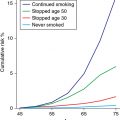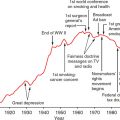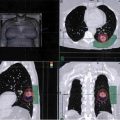A 67-year-old man with past medical history of hypertension and chronic obstructive pulmonary disease (COPD) presents for an annual physical. He has no symptoms. He smoked 1 pack a day for 30 years but quit 5 years ago when he was diagnosed with COPD. He is asking about his risk of lung cancer. What screening modality, if any, you can offer this patient? Learning Objectives: 1. What are the guideline recommendations for lung cancer screening? 2. What are the harms and benefits of lung cancer screening? 3. Is lung cancer screening cost-effective? Lung cancer is the leading cause of cancer-related mortality worldwide. The 5-year survival rate of lung cancer is only 18% because most cases of lung cancer are diagnosed at an advance stage.1 Clinical outcomes of lung cancer are related to the stage at diagnosis, ranging from 56% five-year survival rate for stage I to 4% five-year survival rate at stage VI. Therefore, early detection of lung cancer is an important opportunity to decrease mortality. Screening for lung cancer by chest radiograph (CXR) and/or sputum cytology is not recommended. There have been at least six large randomized controlled trials,2–5 beginning as early as the 1960s, but none of the trials has demonstrated a mortality benefit for CXR screening. However, only the Prostate, Lung, Colorectal, and Ovarian (PLCO) Cancer Screening Trial5 compared screening with no screening. In the Memorial Sloan-Kettering2 and the Johns Hopkins studies,4 a combined total of 20,427 men were randomized to either an annual CXR alone or a CXR in combination with sputum cytology. No difference was noted in lung cancer incidence or mortality between the 2 groups. In the Mayo Lung Project,3 10,993 male smokers underwent a baseline screening with CXR and sputum cytology. If results were negative for cancer, the men were randomized to receive CXR and sputum cytology every 4 months or usual care, which was a recommendation for an annual CXR. After 6 years, the lung cancer mortality rate was not statistically different between the screened and control groups. The PLCO Cancer Screening Trial5 is a population-based study of men and women aged 55 to 74 years for several cancers, including lung cancer. A total 154,901 participants were randomly assigned to receive either annual CXR for 4 years or standard of care (no CXR) and were followed up for 12 years. At the end of the study, the two groups demonstrated similar cumulative lung cancer incidences, lung cancer mortality, and stage and histologic findings of detected lung cancers. Refinement of computed tomographic (CT) scan techniques with evaluation of low-dose CT (LDCT) scan developed interest in CT as screening modality. LDCT refers to a non-contrast study obtained with a multidetector CT scanner during a single maximal inspiratory breath-hold with a scanning time under 25 s and radiation exposure of 1.6 mSv (conventional CT radiation exposure of 7 mSv). Several observational studies on screening with LDCT demonstrated that LDCT can identify early-stage asymptomatic lung cancer. The larger studies included the Early Lung Cancer Action Program (ELCAP), the International ELCAP (I-ELCAP), the Mayo Clinic CT study, and the Continuous Observation of Smoking (COSMOS) study. These observation studies showed that LDCT detected more lung cancers than did CXR, and the majority of these cancers were detected at an early stage. This led to many randomized trials, but only the National Lung Screening Trial (NLST) and the Dutch Belgian randomized lung cancer screening trial (NELSON Trial) were established to assess the mortality benefit of lung cancer screening. The NLST,6 published in 2011, was the first randomized trial to show a mortality benefit to LDCT screening for lung cancer. • The trial compared annual screening by LDCT to CXR for 3 years in 53,454 people aged 55 to 74; participants had at least 30 pack-years of smoking, including current smokers and former smokers who had quit within 15 years. • At a median follow-up of 6.5 years, there was a relative mortality reduction of 20% for lung cancer deaths and 6.7% reduction in all-cause mortality in the LDCT group. • To prevent one lung cancer death, the number needed to screen with LDCT was 320. • Abnormal screening tests occurred in 24% of the LDCT group and 6.9% of the CXR group, >90% of which were false positives. Most only required additional imaging, but some required invasive procedures. Complications from the diagnostic workup were uncommon, involving about 1.5% of the participants who had abnormal screening tests. The NELSON trial presented its mortality results at the World Conference on Lung Cancer 2018, showing a 26% reduction in lung cancer mortality in males at 10 years.7 • This randomized trial compared screening with LDCT to usual care (no screening) in 15,792 people (87% male) aged 55 to 74 years with more than a 15 pack-year smoking history, including current smokers and former smokers who had quit within 10 years. • LDCT was performed at baseline, year 1, year 2, year 4, and year 6.5. • This trial used volume and volume doubling time of nodules rather than nodule diameter. • In the first and second rounds of screening, 2.6% and 1.8% of the participants, respectively, had a positive test result.8 There is currently no high-quality evidence for biomarkers in early detection of lung cancer. Multiple blood/serum biomarkers are under investigation, but worth mentioning are EarlyCDT-Lung, miR-test, and MSC (Micro-RNA signature classifier) as they have entered phase 4 of development.9 1. The EarlyCDT-Lung test is a commercially available blood test based on enzyme-linked immunosorbent assay (ELISA) principles; the test measures a panel of seven tumor-associated autoantibodies: p53, NY-ESO-1, CAGE, GBU4–5, SOX2, HuD, and MAGE A4. EarlyCDT-Lung showed sensitivity, specificity, PPV (positive predictive value), NPV (negative predictive value), and positive likelihood ratio results of 41%, 87%, 11%, 97%, and 3.19, respectively. 2. The miR-test is a serum-based microRNA (miRNA) test that measures a signature of 13 miRNAs: miR-92a-3p, miR-30b-5p, miR-191-5p, miR-484, miR-328-3p, miR-30c-5p, miR-374a-5p, let-7d-5p, miR-331-3p, miR-29a-3p, miR-148a-3p, miR-223-3p, miR-140-5p. The miR-test had sensitivity, specificity, PPV, NPV, and positive likelihood ratio results of 78%, 75%, 10%, 98%, and 3.09, respectively. 3. The MSC is a plasma-based miRNA test that categorizes patients into low, intermediate, or high risk of disease based on predefined positivity for 24 miRNA expression ratios. MSC had sensitivity, specificity, PPV, NPV, and positive likelihood ratio results of 87%, 81%, 27%, 98%, and 4.67, respectively. Multiple medical societies’ guidelines recommend annual lung cancer screening with LDCT in high-risk individuals (Table 10-1).10–13 Some guidelines advise patient counseling on the risks and benefits of screening, importance of smoking cessation, and shared decision-making before testing. LDCT screening as a part of a screening program should only be performed when the clinician and patient are committed to pursuing follow-up investigations, including serial imaging and possible surgical lung biopsy and where there is expertise in lung cancer management. TABLE 10-1 Current Guideline Recommendations for Lung Cancer Screening
10
EARLY DETECTION OF LUNG CANCER
SCREENING MODALITIES
Chest X-ray and Sputum Cytology
Computed Tomographic Screening
Biomarkers
CURRENT RECOMMENDATIONS
Stay updated, free articles. Join our Telegram channel

Full access? Get Clinical Tree







